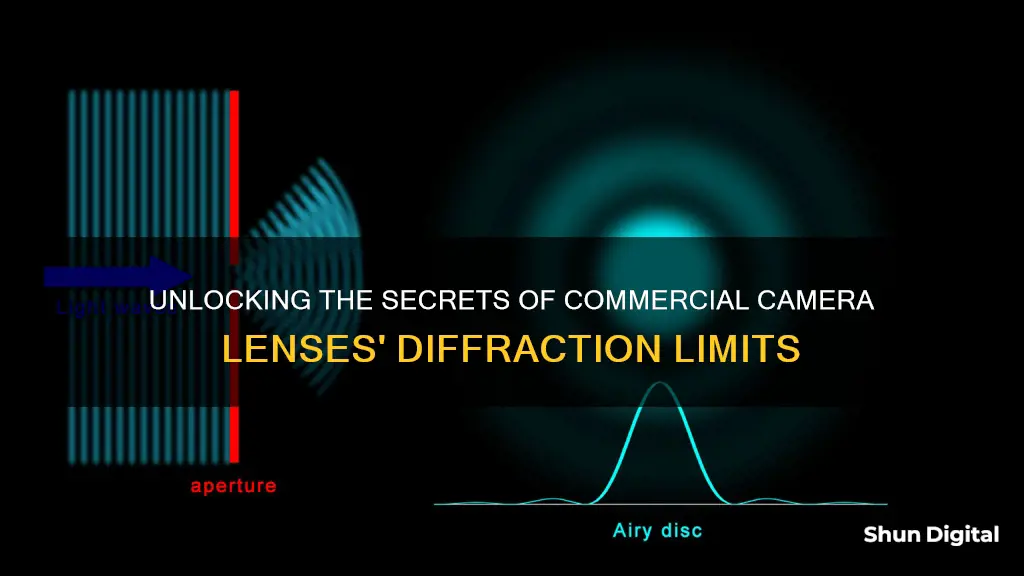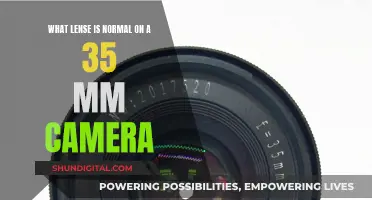
The diffraction limit is the point at which a camera lens can no longer resolve an image usefully. Diffraction is an optical effect that limits the total resolution of a photograph, regardless of the number of megapixels the camera has. It occurs because light begins to disperse when passing through a small opening, such as a camera's aperture. This effect is usually negligible, but for very small apertures, it becomes counterproductive, and the camera is said to have become diffraction-limited.
| Characteristics | Values |
|---|---|
| Definition of Diffraction Limit | The principal limit to a camera's resolution due to the physics of diffraction. |
| Cause of Diffraction | Light waves spread out and interfere with one another when passing through a small opening (camera's aperture). |
| Impact of Diffraction | Loss of sharpness or resolution in photographs. |
| Factors Affecting Diffraction | F-number of the lens and wavelength of light being imaged. |
| Diffraction-Limited Angular Resolution | Proportional to the wavelength of light being observed and inversely proportional to the diameter of the objective's entrance aperture. |
| Diffraction-Limited Spatial Resolution | Proportional to the light wavelength and the numerical aperture of the objective or the object illumination source. |
| Diffraction in Different Instruments | Telescopes, microscopes, and cameras can be diffraction-limited. |
| Techniques to Improve Resolution | Extending numerical aperture, near-field techniques, far-field techniques, and metamaterial-based superlenses. |
What You'll Learn
- Diffraction is an optical effect that limits resolution
- Diffraction occurs when light passes through a small opening
- Diffraction is caused by light waves spreading out and interfering with one another
- Diffraction is worse at small f-numbers, e.g. f/22
- Diffraction is independent of the number of megapixels

Diffraction is an optical effect that limits resolution
Diffraction is an optical effect that limits the resolution of a photograph. It occurs when light passes through a small opening, such as a camera's aperture, and begins to disperse and interfere with one another. This interference creates a pattern with varying light intensities, known as an Airy disk, which causes a loss of sharpness in the final image. The size of the Airy disk depends on the aperture size and the wavelength of light, and when it becomes large relative to the pixel size in the camera, it leads to a visual impact on the image. This impact is gradual and depends on factors such as lens quality and viewing distance.
The onset of diffraction can be observed as a reduction in small-scale contrast or loss of sharpness in fine details. This happens because the Airy disks start to overlap, and the edges within the image lose definition and clarity. As the aperture is further reduced, the entire image will eventually lose sharpness.
The diffraction limit refers to the point where the size of the Airy disk becomes comparable to the pixel size, resulting in a loss of resolution. This limit is independent of the number of megapixels and film format but depends on the lens's f-number and light wavelength. Different camera models and lens combinations will exhibit diffraction effects at different aperture sizes. For example, a Canon EOS 20D may show diffraction at around f/11, while a Canon PowerShot G6 may show effects at f/5.6 due to its smaller sensor size.
Diffraction is a fundamental aspect of photography that cannot be avoided, and it sets a limit on the maximum sharpness achievable. However, it is important to note that other factors, such as lens imperfections, focus accuracy, and motion blur, can also influence the overall image quality.
How to Safely Remove and Clean Your Camera Lens
You may want to see also

Diffraction occurs when light passes through a small opening
When light passes through a small opening, it encounters an obstacle that causes the light waves to diffract or bend around the corners of the aperture. This effect is most noticeable when the size of the gap or aperture is similar to or smaller than the wavelength of the light waves. As a result, the light waves become partially blocked and spread out in a fan-like pattern, known as the "fanning effect." This effect leads to a loss of sharpness and resolution in the resulting image.
In the case of commercial camera lenses, diffraction sets a fundamental limit to the resolution that can be achieved. The smaller the aperture or lens opening, the more pronounced the diffraction effects become. This is because the light waves are forced through a narrower space, causing greater interference and bending. As a result, the light waves that reach the camera sensor are no longer travelling in a straight line, but rather in a fanned-out pattern. This fanning effect causes the points of light in the image to spread out, resulting in a loss of sharpness, particularly at the edges of the image.
To minimise the impact of diffraction when using commercial camera lenses, photographers often aim to use larger apertures (smaller f-numbers) to allow more light to pass through and reduce the degree of bending. For example, using an aperture setting of f/8 to f/11 on a full-frame DSLR camera can help achieve optimum sharpness and depth of field for landscape images. Additionally, the quality of the lens and the size of the camera sensor also play a role in determining the extent of diffraction effects. Larger sensors tend to have larger pixel sizes, which can handle bigger airy discs before exhibiting noticeable diffraction.
How Does an Eclipse Affect Camera Lenses?
You may want to see also

Diffraction is caused by light waves spreading out and interfering with one another
Diffraction is a physical characteristic of all lenses and is an optical effect that limits the sharpness and resolution of images captured by a camera. Diffraction is caused by light waves spreading out and interfering with one another as they pass through a small opening, such as a camera's aperture.
Light can be understood as a collection of particles called photons, or as electromagnetic waves, with its behaviour depending on the circumstances. In the context of camera lenses, it is the wave nature of light that is most important. When light passes through a small aperture, it begins to disperse or "diffract". This effect is typically negligible, as smaller apertures often improve the sharpness of an image by minimising lens aberrations. However, for very small apertures, this strategy becomes counterproductive, and the camera reaches its diffraction limit.
The diffraction limit of a camera refers to the point at which the aperture size is reduced to the extent that the light waves deform and spread out in a fan-like shape as they pass through. This occurs because the aperture, acting as an obstacle, interferes with the light waves. As a result, the light waves begin to diverge and travel different distances, causing them to move out of phase and interfere with each other. This interference creates a diffraction pattern, with areas of increased and decreased light intensity.
The onset of diffraction is gradual, and even before it limits the resolution, it can reduce small-scale contrast by causing the areas of light interference to overlap. Once the camera reaches its diffraction limit, the resolution of the image is impacted, and the edges within the image begin to lose definition and clarity. As the aperture continues to decrease in size, the image loses sharpness, with lines blurring together and the overall image falling apart.
The diffraction limit is influenced by factors such as the size of the camera's sensor, the wavelength of light, and the number of megapixels. Larger sensors, which have bigger pixel sizes, can handle smaller apertures before reaching the diffraction limit. On the other hand, smaller sensors found in point-and-shoot cameras or mobile phones exhibit diffraction effects at larger apertures. Additionally, the diffraction limit is independent of the number of megapixels, as it depends solely on the f-number of the lens and the wavelength of light being captured.
Universal Camera Lenses: A Myth or Reality?
You may want to see also

Diffraction is worse at small f-numbers, e.g. f/22
Diffraction is an optical effect that occurs when light passes through a small opening, such as a camera aperture, and causes a loss of sharpness or resolution in an image. This is because the light rays begin to diverge and interfere with one another as they pass through the small opening, creating a diffraction pattern with areas of higher and lower light intensity. The smaller the aperture relative to the wavelength of light, the more significant this effect becomes.
In the context of commercial camera lenses, diffraction is typically more noticeable at smaller f-numbers, such as f/22. This is because, at these small apertures, the diameter of the central peak of the diffraction pattern, known as the "airy disk", becomes large relative to the pixel size in the camera sensor. Once the airy disk size exceeds what is known as the "circle of confusion" (typically around 2-3 pixels), it starts to have a visible impact on the image, reducing the overall sharpness.
The impact of diffraction on image sharpness can vary depending on factors such as sensor size, pixel pitch, and viewing distance. For example, on a full-frame camera, diffraction may become noticeable at f/11, while on an APS-C sensor, it may be more apparent at f/8. Additionally, the impact of diffraction may be more noticeable when viewing an image at a high magnification (e.g., pixel-peeping) compared to viewing a print or a screen-resolution version.
It is worth noting that diffraction is always present to some degree, even at larger apertures, but it may not be as visually significant. The optimal aperture for maximizing sharpness depends on a combination of factors, including lens quality, aberrations, and the specific camera system being used.
Understanding Camera Lens Interchangeability: What You Need to Know
You may want to see also

Diffraction is independent of the number of megapixels
Diffraction is an optical effect that limits the sharpness and resolution of images captured by cameras. It is caused by the bending of light waves as they pass through a lens aperture, and is determined by the wavelength of light and the diameter of the lens aperture. The smaller the aperture, the more pronounced the diffraction effects, which can cause a loss of sharpness in images.
The impact of diffraction on image quality is more noticeable in cameras with smaller sensors, such as those found in cropped sensors, point-and-shoot cameras, or mobile phones. These smaller sensors exhibit diffraction effects at lower f-stops, such as f/4 or f/5.6. On the other hand, medium and large format cameras can handle much smaller apertures before diffraction effects become visible.
The reason for this difference lies in the concept of the "airy disc". When the size of the airy disc exceeds the size of a pixel in the camera sensor, the camera is considered diffraction-limited. Bigger sensors have larger pixel sizes, allowing them to accommodate bigger airy discs before reaching the diffraction limit. This is why large format cameras can utilize smaller apertures to achieve maximum depth of field, while smaller sensors require larger apertures to avoid diffraction effects.
In summary, diffraction is an optical phenomenon that affects the sharpness and resolution of images, and it is influenced by the sensor size, aperture, and wavelength of light. It is independent of the number of megapixels and is determined by the physical characteristics of the camera and lens system.
Camera Lens: Expensing or Depreciating?
You may want to see also
Frequently asked questions
The diffraction limit is the point at which a lens's resolution is no longer improved by stopping down the aperture. Diffraction is an optical effect that occurs in all lenses and causes a loss of sharpness or resolution in photographs. This happens because as the aperture gets smaller, light waves spread out and interfere with each other, resulting in blurring of fine details. The specific diffraction limit will vary depending on the camera lens combination and other factors such as sensor size and wavelength of light.
The diffraction limit impacts the sharpness and resolution of your photographs. As you stop down your lens to smaller aperture values (e.g. f/16, f/22), the finest details in your photos will begin to blur due to the increasing diffraction effects. This can be a concern for photographers who want to capture sharp images, especially in landscape and architectural photography where depth of field is important.
While diffraction is a result of the physics of light and cannot be completely avoided, there are strategies to minimise its impact. Using larger apertures (e.g. f/5.6, f/8) can help as diffraction is less significant at wider apertures. Additionally, focus stacking techniques and post-processing sharpening can improve apparent sharpness in your photos.
While the diffraction limit does impact sharpness, there are situations where stopping down beyond this limit can still be advantageous. Smaller apertures increase the depth of field in your photographs, allowing you to have more of the scene in focus. This trade-off between sharpness and depth of field is an important consideration in photography, especially in landscape and macro photography.







